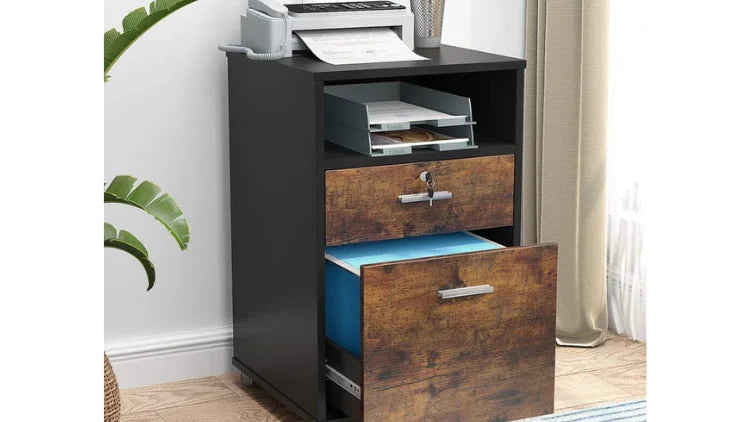What is a File Cabinet?
A file cabinet (or filing cabinet) is a sturdy storage unit designed to organize and protect documents, folders, and office supplies. Typically made of metal or wood, it features drawers that slide in and out for easy access to files. File cabinets are essential for offices, homes, and institutions to maintain an orderly system for paperwork.

Key Features of File Cabinets
- Durable Construction – Made from steel, aluminum, or wood to withstand heavy use.
- Sliding Drawers – Equipped with rollers or tracks for smooth operation.
- Locking Mechanisms – Many include locks for securing sensitive documents.
- Standardized Sizing – Designed to hold letter-size (8.5" × 11") or legal-size (8.5" × 14") files.
Related read: How to Find the Best File Cabinets With Locks for You
Safety First: Prepare Your Workspace
Before attempting to remove any drawers, follow these precautions:
- Empty the drawer completely – Unbalanced weight can cause jamming or tipping.
- Wear work gloves – Protect your hands from sharp metal edges, especially on older cabinets.
- Lay down a soft surface – Place a towel or cardboard under the drawer in case it drops.
Tools You Might Need
Most modern file cabinets allow tool-free removal, but keep these handy just in case:
Phillips-head screwdriver (for older cabinets with screws)
Pliers (to loosen rusted components)
Lubricant (WD-40 or silicone spray) (if drawers stick)
Method 1: Standard Side‑Rail Drawers (Most Common Type)
Fully extend the drawer until it stops — you may hear a click.
Locate the release mechanism: If there are plastic tabs, press inward on both sides while gently pulling.
If there are metal levers, lift or push them outward near the tracks.
Slightly tilt the drawer downward (about 15°), then carefully slide it out.

Method 2: Roller‑Track Drawers (Heavy‑Duty Cabinets)
Pull the drawer all the way out until the rollers reach the end of the tracks.
Lift the front edge of the drawer to disengage the rollers.
Tip: Ask for help if the drawer is heavy.
Method 3: Screw‑Secured Drawers (Common in Vintage or Metal Cabinets)
Open the drawer and remove the bottom panel to access the mounting screws.
Use a screwdriver to carefully remove the screws securing the drawer.
Pro tip: Store the screws in a labeled bag for easy reassembly.
Method 4: Lever Disconnect Drawers (Found in Heavy‑Duty Slides & Workstations)
Extend the drawer fully until it stops.
Locate the spring-loaded levers on both sides of the drawer slides (inner member).
Simultaneously lift one lever upward and push the other downward — this disengages the drawer from the slide.
While holding the levers in place, gently pull the drawer straight out.
Note: These slides often have built-in lock-out or stop-out features for safety.
How to Reinstall Filing Cabinet Drawers?
Method 1: Standard Side-Rail Drawers
- Align the drawer tracks with the cabinet rails, keeping both sides level.
-
Gently slide the drawer inward until you hear or feel it click into place.
- Open and close the drawer a few times to ensure smooth operation.
Method 2: Roller-Track Drawers
- Lift the drawer slightly to align the rollers with the tracks.
-
Slide the drawer in slowly, making sure the rollers engage properly.
- Test by fully extending the drawer and pushing it back in smoothly.
Method 3: Screw-Secured Drawers
-
Line up the drawer with its mounting holes inside the cabinet.
-
Reinsert and tighten the screws with a screwdriver.
-
Pro tip: Use the labeled bag of screws you saved earlier.
- Reattach the bottom panel if removed, and test the drawer for proper fit.
Method 4: Lever Disconnect Drawers
- Align the drawer slides with the tracks inside the cabinet.
- Slowly insert the drawer, making sure the slide members engage properly.
- Push the drawer in until you hear both levers click into place — this indicates that the spring-loaded levers have re-engaged.
- Test the drawer by pulling it out and pushing it back in to ensure it glides smoothly and locks correctly.
- Note: For models with lock-out or stop-out features, make sure the locking mechanism is re-engaged before full use.

Final Thoughts
With the right technique, removing a file cabinet drawer is quick and safe. Be careful - forcing a drawer apart may cause the tracks to bend or the plastic parts to break. If your file cabinet is damaged and unusable, feel free to purchase a new one at Tribesgins, or contact us if you find any installation parts are missing.
Read more: How to Dress Up A Metal File Cabinet



